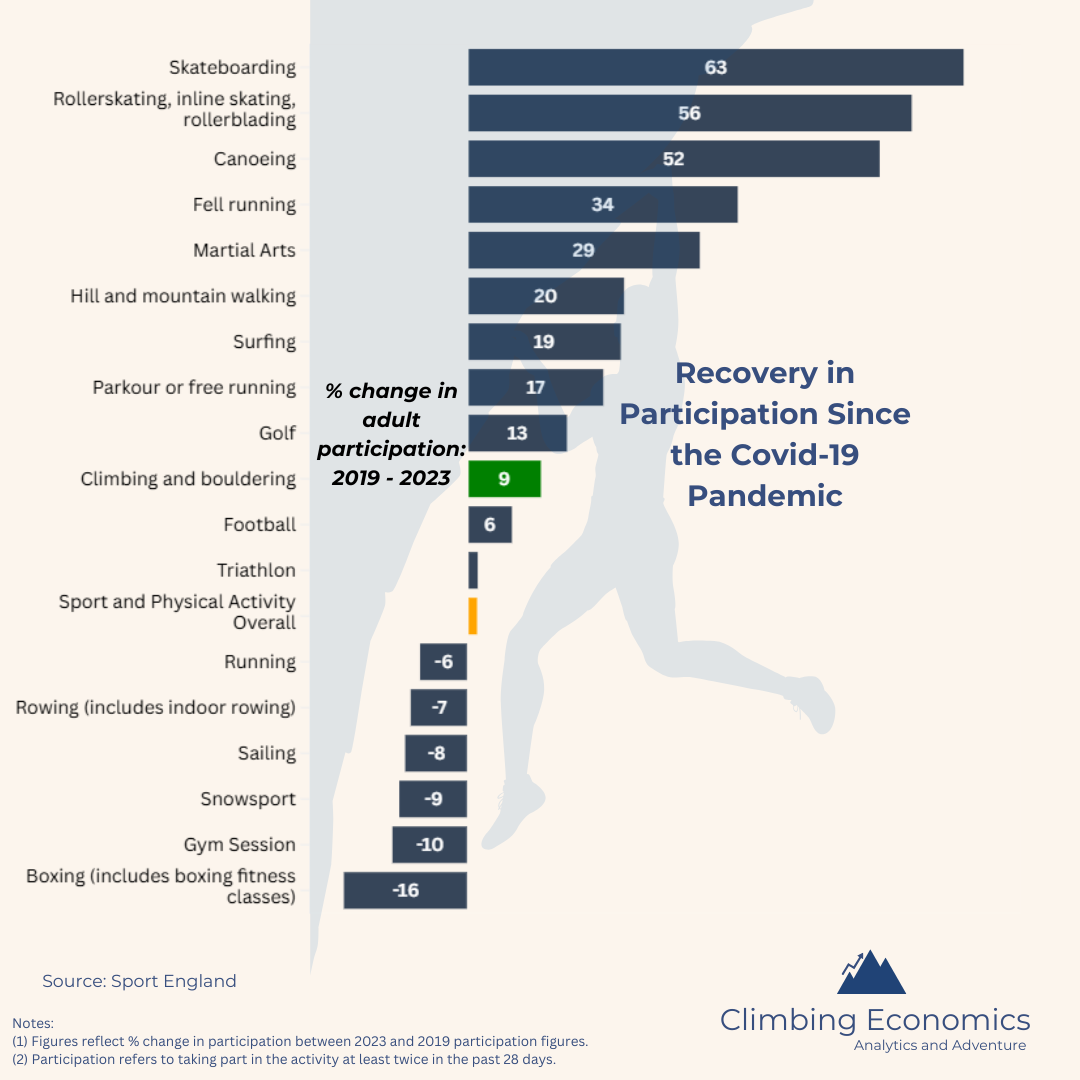The Covid Comeback: Which Sports Have Recovered Their Momentum?
And, how does the growth of climbing stack up against other sports in England?
In my last article, I discussed the modest and stable growth of climbing since 2016, and encouraged readers to be more critical of the statistics they hear in the news: they are often over-hyped.
The article received positive feedback from industry leaders who have argued that climbing is not a bubble, but that its growth reflects a strong and sustainable take-up of the sport.
One of the main questions I received was how the recovery in participation in climbing since the Covid-19 pandemic compares to other sports. So, this week, I delve into the Sport England data to have a look at which sports have returned to their pre-Covid levels of participation and which ones are still lagging behind.
The Data
The Sport England participation figures charted below are calculated based on results from the Active Lives Survey¹, and reflect the number of adults that took part in each activity at least twice in the last 28 days. The sports presented in the chart are based on my own selection. Each bar represents the % change in adult participation from 2019 to 2023.
Observations
The Gainers
We can immediately see that some sports have far exceeded their 2019 levels, whilst others haven’t yet recovered. Skateboarding and Rollerskating have been the biggest gainers since 2019 with participation growing 63% and 56% respectively. Canooeing, Adventure Sports (including mountain walking and fell running) Sports, Surfing, Parkour and Golf have all seen increases in participation above 10%.
These sports are generally carried out in the outdoors, and, excluding golf, require relatively little initial expenditure, an important factor to consider given the current cost-of-living crisis. It’s plausible that the growth in golf has been powered by work-from-home and hybrid work arrangements.²
Furthermore, participation in some of these sports actually grew during Covid, likely benefitting from the closure of traditional gyms and fitness classes. Stand Up Paddleboarding, for example, provided the opportunity to get in touch with nature, socialize and keep fit, all whilst adhering to social distancing regulations.
Climbing and Bouldering sits near the bottom of the sports that have surpassed their 2019 levels, with a 9% increase, just above Football (6%). Overall participation in sports, as indicated by the orange bar, has rebounded to 2019 levels but shows little growth beyond that. This indicates that recent sporting trends have been characterized more by individuals transitioning between different sports than by a significant increase in new participants becoming active.
Still Catching Up
The Covid-19 pandemic has clearly had a negative effect on some sports.
Naturally, activities generally taking place indoors, such as traditional gym sessions (including indoor rowing) and boxing classes, have suffered as people have moved outdoors for the various reasons discussed above. It is worth noting, however, that Martial Arts participation has increased, possibly driven by recreational boxers discovering alternative combat sports as well as an increased interest in self-defence.
Snowsport participation was hugely affected by the travel restrictions induced by Covid-19, and will likely continue to be affected by warmer winter seasons abroad and the increasing costs of travelling. Those affected will be forced to substitute towards extreme sports that can be carried out in the UK, such as Skating, Climbing and Mountain Biking.
It is surprising to me that Running has experienced a drop in participation, particularly given the numbers I now see showing up at my local Parkrun. Some of it could be driven by how the data is collected, with more runners being classified as Fell Runners as people have moved out of cities and into the countryside. However, further research is needed to understand why running participation hasn’t stabalized back at its pre-Covid levels.³
Sailing falls into a another bucket among sports that have been seeing a long-term decline in participation, possibly due to its high financial barriers to entry.
Conclusion
In this article, I have contextualised the growth of climbing by analysing participation trends among a selection of other sports.
Since the Covid-19 pandemic, participation in "nature-based sports" has significantly increased, likely driven by their compatibility with social distancing measures and a heightened desire to connect with nature.
Sports with traditionally higher entry costs have likely been adversely impacted by reduced disposable income for leisure activities, a consequence of the ongoing cost-of-living crisis. Activities like skiing and snowboarding may face sustained declines in participation, driven by the combined challenges of higher travel expenses and the effects of warmer winters.
Climbing has returned to, and exceeded, its 2019 levels. Its growth is impressive, particularly given that it has faced the same challenges, such as social distancing regulations during the pandemic, that have led to decreased participation in other predominantly indoor sports. As more and more people (particularly Gen Z⁴) look for healthy alternatives to meet up, and because of the increased interest resulting from the Olympics, this stable growth will likely continue in the near future.
Footnotes
1 https://www.sportengland.org/research-and-data/data/active-lives?section=overview
2 https://nbloom.people.stanford.edu/sites/g/files/sbiybj24291/files/media/file/golfingfromhome.pdf
3 https://www.runningindustryalliance.com/runners-participation-over-the-last-12-months/
4 https://thekit.ca/living/living-relationships/nato-dating-trends-2024-tinder-bumble/

